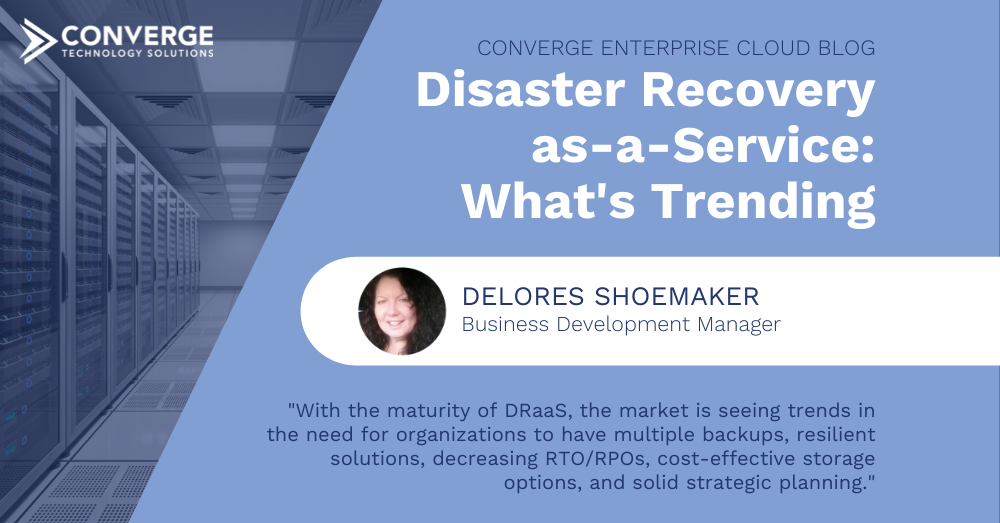Disaster Recovery as a Service (DRaaS) has evolved over the last couple of decades. With that evolution, it has become an attractive option for organizations that want to free up IT resources from day-to-day tasks to focus on projects that create value-add. In addition, DRaaS continues to benefit small and midsize businesses that have leaner IT teams or lack a secondary site and experienced staff to run it. DRaaS providers offer a range of services from self-managed to fully managed with customizable options for private/public cloud, hybrid solutions, and managed recovery assistance. With the maturity of DRaaS, the market is seeing trends in the need for organizations to have multiple backups, resilient solutions, decreasing RTO/RPOs, cost-effective storage options, and solid strategic planning.
Multiple Backups
Data is often the most valuable asset of an organization. With the increase in ransomware attacks, protecting data has become a key focus for IT teams, management, and C-level alike. Working from home has also presented new security concerns as hackers have become more sophisticated, making their attacks harder to spot and putting organizations at more risk. Backups are no longer viewed as just a way to recover an accidentally deleted file or protection against natural disasters. They are essential to avoid the threat of “pay me or else.”
Loss of critical data not only impacts customers and employees but can have a far-reaching domino effect on an organization’s vendors and partners. Downtime and data loss caused by hostile attacks can effectively drive organizations out of business.
Many organizations have chosen to mitigate that risk by ensuring they have multiple copies of their data, keeping backup copies locally, at one of their own secondary locations, or with a DR provider and going one step further by adding private or public cloud data backups to their strategy.
Resilience
Decreasing RTO/RPOs is becoming more important than ever. The need to recover quickly with minimal data loss has organizations focused on DRaaS solutions. Many organizations work with providers to create an offsite hybrid or cloud-based environment that allows for replicating both critical data and servers.
For organizations, being resilient means restoring data and applications quickly with continuous data protection that allows the flexibility to choose a recovery point at as little as seconds before the data loss happened. By leveraging an experienced DRaaS provider, organizations of all sizes can significantly improve or increase risk mitigation. Driving factors are the need for smaller recovery windows, shorter downtimes, and the potential for cost savings over in-house solutions.
Tiered storage
Many things have changed with data storage and backup solutions, including the amount of data now being kept. Datastores have grown from mere gigabytes to thousands of terabytes or hundreds of petabytes. Today, organizations can choose to protect data with tiered storage by leveraging options built into data protection software, disk arrays, and cloud solutions. Critical data can be kept readily available on faster storage like flash.
Older or less critical data or data required for legal or HIPAA compliance can be stored in an archive tier offsite in a private or public cloud while keeping it accessible when needed. Having the capability to tier storage also offers organizations a cost-benefit while giving more control over the size of data backups.
Need for DR Planning
IT Disaster Recovery planning provides a roadmap for the recovery of critical business systems in the event of disruption caused by a natural disaster, system failure, or nefarious attack from inside or outside the organization. Every organization needs a testable recovery plan, but many did not realize how critical that need was until the pandemic hit and exposed vulnerabilities. Not having a plan puts organizations at risk of reputation loss, high financial costs from downtime or ransom payments, and can create issues for their customers and vendors. Having a comprehensive written plan allows for preventative measures to reduce risk by providing validation through testing, understanding the entire IT environment, and IT recovery requirements. In addition, it ensures that multiple individuals in an organization have access to the information and steps needed to recover. DR planning can also enable greater customer retention, assuring that if an event should occur, service interruptions will be minimal or even non-existent.
Now that you are in the know, making informed decisions to outsmart business risks is simple. Safeguarding business operations with a solution customized to meet your organization’s unique requirements is a need, not a want, for all organizations in today’s world. Our team would welcome the opportunity to help develop your DRaaS strategy. Your employees, vendors, partners, and most importantly, your customers are relying on you. They deserve your protection – don’t wait until it is too late!
